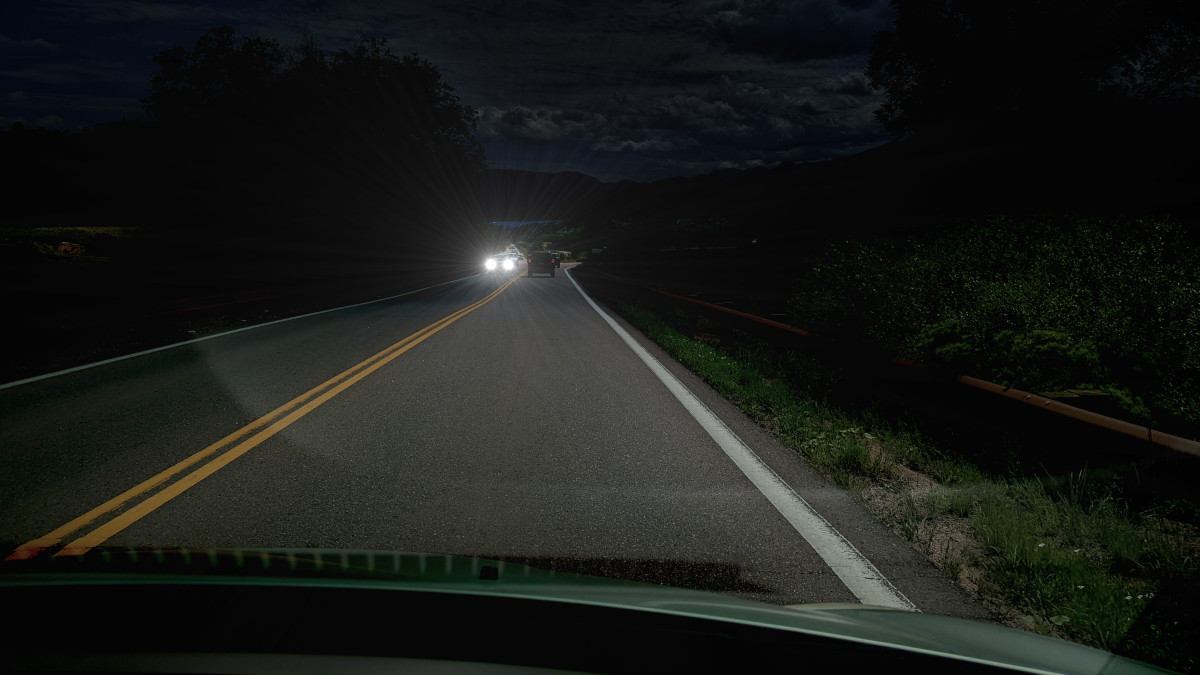Many people hate driving at night because it’s harder to see. Part of what makes night driving difficult is the glare from oncoming headlights.
Although you can’t control the behavior of that lifted truck owner who refuses to adjust his headlights properly, there are some steps you can take to minimize glare from oncoming headlights and maximize your vision of the road ahead.
What Causes Headlight Glare?
When an oncoming car shines its headlights in your direction, the light from the headlights is scattered through tiny imperfections in the windshield. Instead of passing straight through the glass, these imperfections bounce the light around at different angles, creating a haze or halo effect on the glass. This can happen when the windshield is damaged, but also when it is dirty.
Sponsored Links
Ideas That Help Avoid Glare
Here are a few ideas that may help you combat glare from oncoming headlights. A few of these items are great quality of life improvements that will make your drive more pleasant no matter the road conditions.
1) Clean Windshield
Maintaining a clean windshield is very important for good visibility. If you have excessive dust or dirt buildup on the outside of the windshield, this could obstruct your view.
Don’t neglect the inside of your windshield, either. Even if you don’t touch the inside of the windshield, you will find it gets dirty after a while due to off-gassing from the dashboard, and other interior materials. This is especially true of newer cars.
Streaks and smudges on the interior are even more likely to cause glare from oncoming headlights. These translucent films are likely to refract the light and make it much harder to see. A greater portion of the windshield will be blocked because of the way light scatters as it passes through the thin film of buildup.
Sponsored Links
To clean the exterior of the windshield, you can usually just wash the car normally. If this is insufficient, or you wish to clean the windshield without washing the car, check your local auto parts store for auto glass cleaner.
To clean the inside of the windshield, first wipe the windshield down with a dry microfiber. Next, degrease the windshield. You can use a microfiber towel dipped in rubbing alcohol or a moistened magic eraser for this step. Finally, follow up with your favorite interior glass cleaner and wipe dry with a fresh microfiber.
2) Rain-X, Wax, or Ceramic Coat the Windshield
As a final step to cleaning the windshield, apply a hydrophobic layer to the outside of the windshield. This could be a product like Rain-X, carnauba wax, or a ceramic coating specifically designed for auto glass.
When you apply a hydrophobic layer, water beads up and runs off the windshield without sticking. This gives you a crystal clear view of the road ahead, even when it’s pouring down rain. You may not even need to turn the windshield wipers on!
Sponsored Links
To combat fog, put a pea-sized amount of dish soap onto a microfiber. Rub this into the inside of the windshield until you can’t see it anymore. This thin film of soap is clear enough to see through perfectly. The presence of the soapy film repels moisture and keeps your windows from fogging up.
3) Replace Your Old Windshield
Over time, rock chips and regular wear will scratch the surface of the windshield. The more imperfections you have in the glass, the more light will bounce around at undesirable angles when it passes through the windshield.
Windshield replacements are often fairly inexpensive and can help clear up visibility immensely. If your vehicle has radar behind the windshield, it may need to be recalibrated after replacing the windshield. This could add to the cost of the repair. Many insurance companies cover windshield replacement.
4) Dim Your Instrument Cluster and Interior Lighting
Sometimes it might feel like the glare is coming from outside the car, when in fact you’re being blinded by interior lighting. If you have a hard time seeing at night, try dimming your instrument cluster.
Sponsored Links
It’s a good idea to drive without any lights on in the cabin, with the exception of a dimmed gauge cluster so you can see important information about your vehicle. Dimming the interior lights helps preserve your night vision, allowing your pupils to dilate more. The more dilated your pupils, the more light you can take in from outside the car.
5) Don’t Look Directly at Headlights
Looking at oncoming headlights ruins your night vision, making it harder to see the road even after the car passes. Do your best to look away from oncoming headlights, while maintaining a clear view of the road ahead.
One way you can do this is to look at the fog line on the outside of the road, farthest away from oncoming traffic. If you can see the fog line, you know where the road is going without having to look directly in front of you.
It’s important to maintain good vision while driving, especially at night. Look as far down the road ahead as you can. Make note of where you first notice the oncoming headlights, so you can see where the road will go before you get there.
Sponsored Links
6) Upgrade Your Headlights
The brighter your headlights are, the less contrast you will see between bright oncoming headlights and your own. If your car came from the factory with halogen headlights, you might want to look into buying an LED conversion kit.
Once you upgrade your headlights, make sure you take the time to aim your new headlights. Properly aimed headlights give you the best view while minimizing glare for other drivers.
7) Wear Anti-Glare Glasses
Anti-glare glasses are coated with a special material that makes it easier to drive at night. Anti-glare glasses help prevent the halo or star-shaped aura around bright headlights that temporarily blind you.
Anti-glare glasses are available in prescription and non-prescription lenses. If you wear prescription glasses that do not have an anti-glare coating, there are clip-on variants that will help cut down glare. Many of these lenses are tinted yellow, and are sometimes called night driving glasses.
Sponsored Links
What If I Still Can’t See?
Some people may try every suggestion on this list and still struggle with headlight glare. For instance, people with astigmatism are particularly vulnerable to being blinded by headlight glare due to the shape of the lenses in their eyes.
If you struggle with headlight glare after trying all of these options, talk to your doctor or optometrist to see if they offer any solutions that can correct or compensate for your specific circumstances.
If you still feel like you’re not comfortable driving at night, try to stick to day time driving when you can. If this is not possible, some routes may offer more protection from oncoming headlights than others. You may also want to practice night driving at lower speeds, in an area with little to no traffic. This may help you get used to the lower visibility.
Conclusion
If you feel like you can’t drive safely at night, don’t worry; you’re not alone. There are many steps you can take that will make night driving more comfortable.
Sponsored Links

